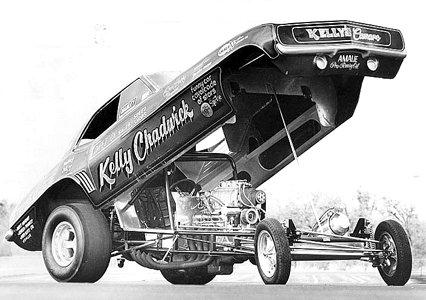|
The 1962 and 1963 Texas vs. California Challenge Drag Races probably
reached their zenith, if you go by how many classes consisted of the
interstate rivals.
In 1962, the promoters came out with a 25-cent program featuring Moss's
streamlined twin blown Chevrolet gas burning dragster on the cover.
When you opened the four-page booklet, there was an expansive list of
events with the Dragmaster Dart of Jim Nelson and the twin blown Pontiac
dragster of Eddie Hill featured prominently.
Other changes had been made as well. Chrondek Company installed a new
foul light system similar to the one run at NHRA national and regional
events. Also, top-end win lights were used for the first time at the
track and 2,000 new bleachers were added to handle the ever-building
crowds at Amarillo.
In addition, NHRA, which sanctioned activity at Amarillo, introduce
a corrected-to-sea-level record system for the track. Amarillo's altitude
made it especially hard to set records, so a mathematical factor was
introduced. The corrections would apply only to unblown cars at the
event as supercharger manifold pressure could be raised to equal sea
level conditions at any altitude.
As significant was the nature of the competition. Even though the Texas
vs. California Challenge Drags were a mere three years old, it had always
been hard to keep the racing divvied up exactly along the lines of the
two states. Too many other racers from other states (400 plus in number)
wanted to play and the 1962 event was no different in this regard. Amarillo
management had received entries from Kansas, Colorado, New Mexico, Oklahoma,
Tennessee, Nebraska, Wyoming, Missouri, and Louisiana.
CONTROVERSY ARISES
The star of the 1962 show was hometown racer Moss. He performed double
duty at the track, winning A/Dragster for car owner Gene O'Tanger and
then taking his own AA/Dragster and winning class with that. The AA/Dragster
title was really a hard-fought affair for Moss as he had to beat Prentiss
Cunningham and NHRA Winternationals champion Jack Chrisman before singling
for the crown.
In the runoff for Top Eliminator, Moss elected to drive his twin, so
Chrisman came over and drove for O'Tanger, and this led to the first
controversy of the meet; one that to this day still rankles the now
78-year-old Moss.
"What they did back then was that the flagman (starter) would jump
up and raise the flag which was on the button, and if one of the racers
took off too soon, it would come up a foul," said Moss. "Well, Chrisman
must've moved 18 inches before I took off and when I did, they said
I jumped the start. I fouled. I couldn't believe it. I saw Chrisman's
tires smoke; that's why I hit the throttle. I saw a home movie of the
race later on and it confirmed what I had seen. Well, Walker said it
was a good start and I just threw up my hands at that point."
Again, with the exception of Middle Eliminator (which was won by the
Westenberger-Bill-Reath team), the Texans and a New Mexican (the late
Dickie Harrell in Stock) swept the eliminators. Yet, because of how
the points worked, California won again.
The 1963 race was the last of the Texas California Challenge Drags
where all classes competed along those lines. California won again with
Hawaiian-born Danny Ongais driving the Dragmaster Dart past Bennie Osborn's
twin Chevy and Prentiss Cunningham to win AA/D. This put him up against
the first nitro car to make a Texas-California finale, Bobby Langley.
Ongais, who set low e.t. at 8.64, defeated Langley.

|